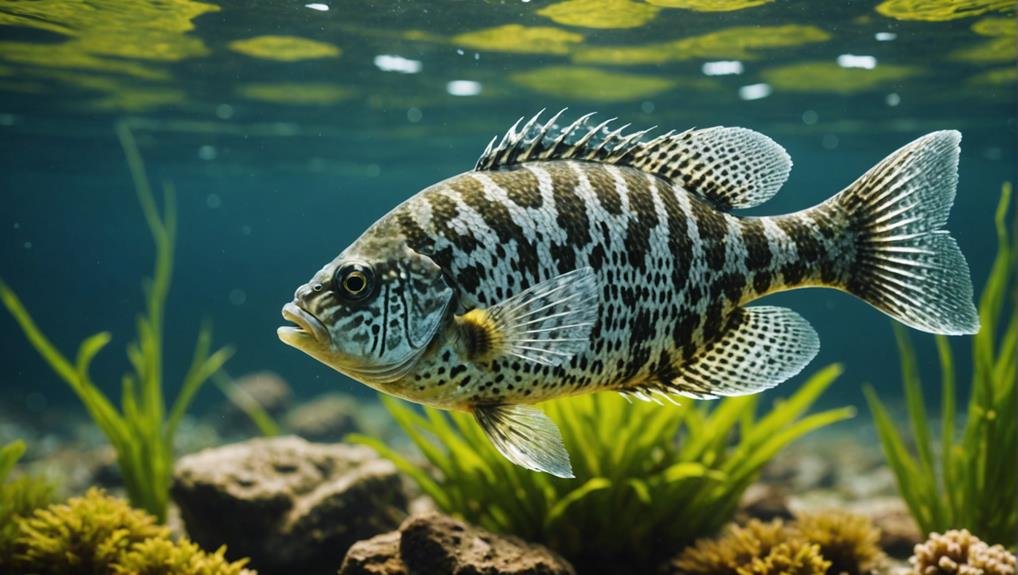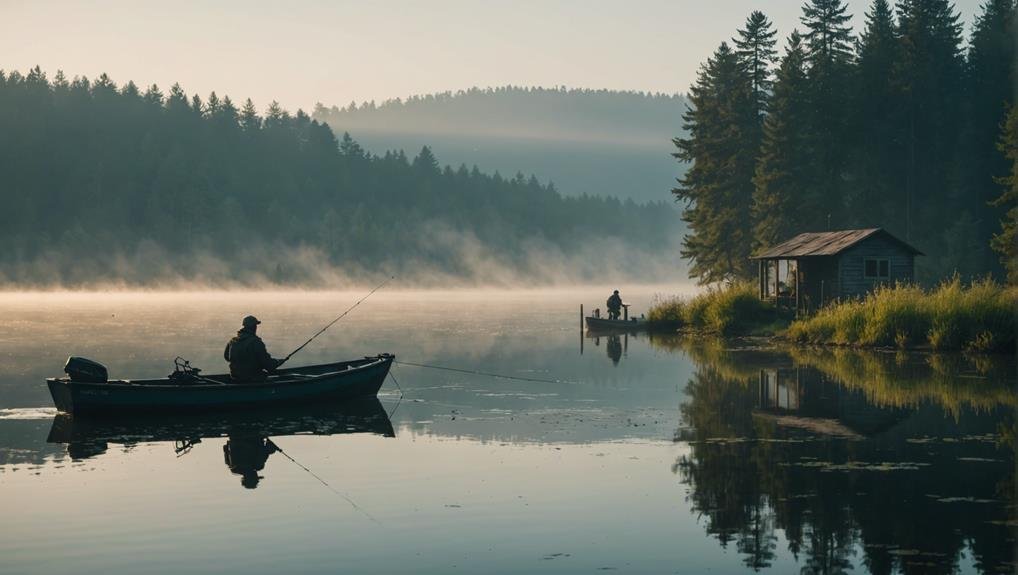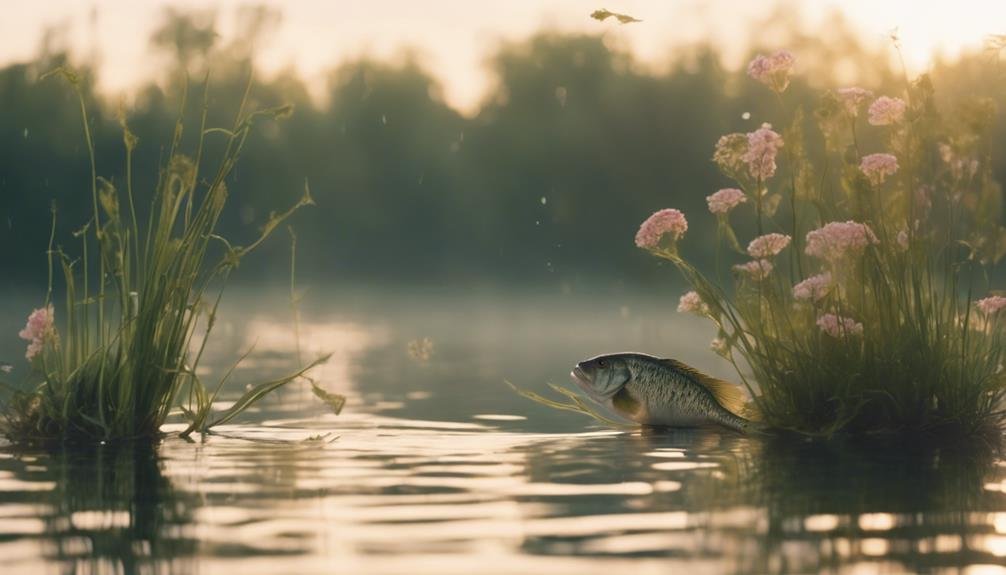You might wonder when crappie spawns, especially if you aim to catch them at their peak. The spawning period isn’t uniform and can vary greatly based on location. In southern states, crappie often begins spawning as early as February, while in places like Texas, the timing can be a bit unpredictable due to fluctuating weather conditions. Typically, crappie prefers water temperatures around 60-63°F for spawning. But there’s more to it than just temperature; understanding the specific behaviors and ideal locations for spawning crappie could make all the difference in your fishing success.
Key Takeaways
- Crappie spawn begins when water temperatures reach 50 degrees Fahrenheit.
- Female crappie lay eggs when water temperatures are in the mid-60s.
- In southern states, crappie spawning often starts in February.
- Ideal spawning water temperatures range from 60-63 degrees Fahrenheit.
- Spawning locations include docks, brush piles, reeds, and cattails.
Crappie Spawn Timing

Understanding crappie spawn timing is essential if you want to maximize your fishing success. The crappie spawn typically begins when water temperatures reach around 50 degrees. This critical temperature signals the start of the spawning period, which can vary by location. For example, in many regions, you can expect the crappie spawn to commence in late March.
During this time, male crappie plays a pivotal role as they move into shallow water and stage around structures like dock systems and rock piles. These areas are prime spawning grounds. The males prepare these spawning areas for the females to arrive.
When water temperatures climb into the mid-60s, the female crappie moves to these spawning grounds to lay their eggs.
Understanding these water temperatures and crappie behavior during the spawn can greatly boost your fishing success. Targeting shallow water and focusing on these specific spawning areas can increase your chances of a good catch. So, keep an eye on the thermometer and be ready to act when the conditions are right for the crappie spawn.
Regional Spawn Differences
While understanding the general timing of the crappie spawn is helpful, it’s important to recognize that spawn timing can vary greatly based on your region. Numerous factors like water temperature and weather conditions influence regional spawn differences. For example, southern states like Texas often experience earlier spawning dates than northern regions.
Due to warmer weather, the crappie spawn can start as early as February in certain areas in Texas. This early start is especially noticeable in East Texas, where females move to staging areas before spawning. However, weather fluctuations can extend the crappie spawn period, sometimes lasting from February through April.
To give you a better idea of how regional spawn differences can affect your fishing experience, consider the following:
- Southern States: Expect earlier spawn dates, often starting in February.
- Texas: Varying start dates due to water temperature and weather conditions.
- East Texas: Females move to stage areas early, extending the spawning period.
- Weather Fluctuations: Can prolong the spawn duration from 4 to 6 weeks.
Ideal Water Temperatures

For crappie to spawn successfully, you’ll need to monitor water temperatures reaching around 60-63 degrees Fahrenheit. These are the ideal temperatures for crappie spawning, and ensuring water temperatures remain within this range is vital for a successful spawn. Both black crappie and white crappie prefer these stable water temperatures, although there can be slight variations in their exact preferences.
When the water hits that sweet spot, the spawn happens, and you’ll notice increased crappie activity. Black crappie might start spawning slightly earlier than white crappie, but both species rely on stable water temperatures to trigger their spawning behaviors.
Regional variations can affect these temperatures, with northern sections of lakes and headwaters of reservoirs often warming up first, initiating the spawning times.
Understanding these regional variations is key to predicting when crappie spawning will occur in your area. Consistent, stable water temperatures around 60-63 degrees are essential. If temperatures fluctuate too much, it could delay or disrupt spawning.
Spawning Locations
You’ll often find crappie spawning around hardcover like brush, docks, reeds, and cattails, which provide essential protection. These environments offer crappie the shelter they need to lay their eggs and safeguard their nests from predators and wind. Artificial and natural covers are equally important, guaranteeing the fish feel secure during this critical period.
When scoping out crappie spawning locations, prioritize areas with visible hardcover. Here are four spots to take into account:
- Brush Piles: Submerged brush piles act as natural barricades, giving crappie a haven to spawn.
- Docks: Manmade structures like docks offer excellent coverage and are easily accessible for crappie to build their nests.
- Reeds: Dense clusters of reeds provide a thick, protective barrier against predators.
- Cattails: These tall plants near the shoreline create a sheltered environment ideal for crappie spawning.
Understanding these spawning habitats is critical. Crappies instinctively seek out these protective areas to secure the survival of their offspring. By focusing on locations with ample cover, you can better predict where crappie are likely to spawn and observe their nesting behaviors. This knowledge is essential for anyone studying or enjoying the crappie spawning season.
Fishing Strategies

To maximize your success during crappie spawning season, employ targeted fishing strategies focusing on the fish’s nesting habits and preferred habitats. Start by targeting spring crappie in shallow waters, where temperatures warmed enough for spawning. These fish often congregate around spawning banks and nesting cover, making these prime spots for your efforts.
Utilize baits like the Bobby Garland StrollR and Swimming Minnow to attract big fish in these areas. Precise bait placement is essential when targeting crappie in nesting cover, increasing your chances of a successful catch.
The 3-inch Slab SlayR is highly effective, allowing you to get your bait right where it needs to be.
Don’t overlook fishing around docks, especially for catching big female crappie during the spawn. Baits from the Bobby Garland Itty Bit Series are particularly productive when fishing docks.
These fishing strategies will help you capitalize on the crappie’s predictable spawning behavior. By focusing on water temps, shallow areas, and precise bait placement, you’ll be well-prepared to catch those big fish during the spring crappie spawning season.
Conclusion
To catch crappie during their spawn, you must pay attention to water temperatures and regional differences. In southern states, they usually start spawning in February, while in Texas, it varies more.
Look for ideal temperatures between 60-63°F and head to shallow waters near structures like docks and rock piles. You’ll have a successful fishing season by targeting these areas with the right strategies.
FAQs
When does crappie spawn occur?
Crappie spawn typically occurs in the spring when water temperatures reach between 60°F and 68°F (15°C and 20°C). The exact timing can vary based on geographic location and local climate conditions. In southern regions, spawning may start as early as March; in northern areas, it might occur in late April to early May.
What behavior do crappie exhibit during spawning season?
During the spawning season, crappie moves into shallow waters to build nests and lay eggs. Males create and guard the nests in sandy or gravelly areas with some cover, such as vegetation or submerged structures. Crappies become more aggressive and concentrated in these shallow spawning areas, making them easier to locate and catch.
What are the best tips for fishing crappie during the spawn?
To fish for crappie during the spawn:
- Target Shallow Waters: Focus on areas with depths of 1 to 6 feet where crappie build nests.
- Use Small Jigs and Minnows: These baits are highly effective during the spawn. Small jigs (1/32 to 1/16 oz) and live minnows are particularly appealing.
- Fish Near Cover: Look for vegetation, submerged logs, and other structures where crappie are likely to nest.
- Be Patient and Stealthy: Approach spawning areas quietly to avoid spooking the fish and give them time to take the bait.
Understanding the crappie spawn and adjusting your fishing techniques can lead to a more successful and enjoyable fishing experience.

